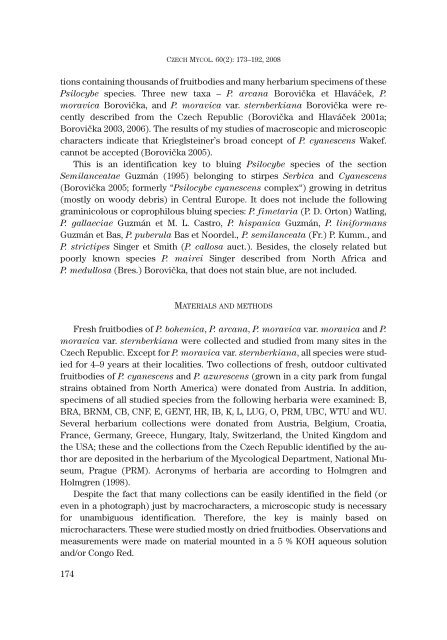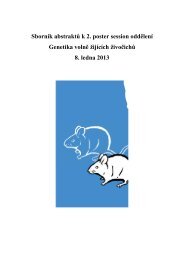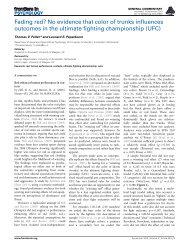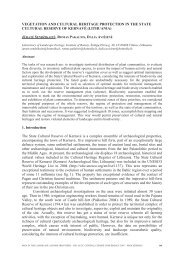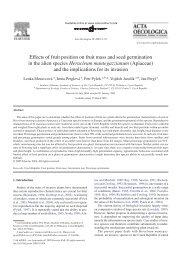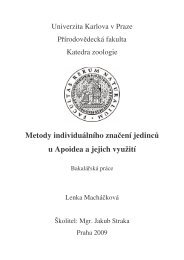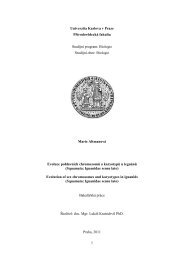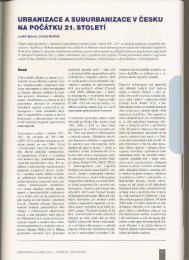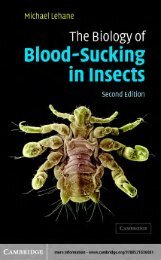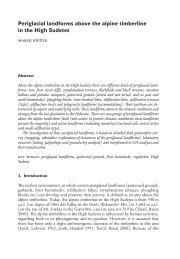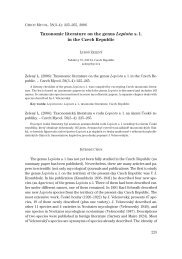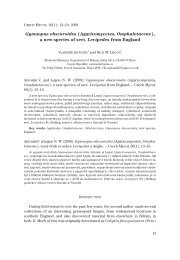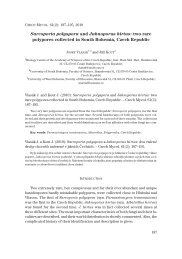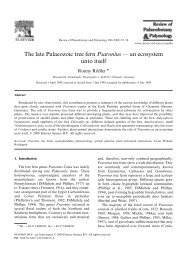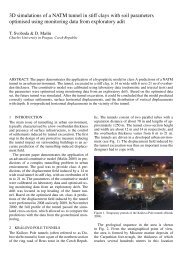The wood-rotting bluing Psilocybe species in Central Europe – an ...
The wood-rotting bluing Psilocybe species in Central Europe – an ...
The wood-rotting bluing Psilocybe species in Central Europe – an ...
You also want an ePaper? Increase the reach of your titles
YUMPU automatically turns print PDFs into web optimized ePapers that Google loves.
tions conta<strong>in</strong><strong>in</strong>g thous<strong>an</strong>ds of fruitbodies <strong>an</strong>d m<strong>an</strong>y herbarium specimens of these<br />
<strong>Psilocybe</strong> <strong>species</strong>. Three new taxa <strong>–</strong> P. arc<strong>an</strong>a Borovička et Hlaváček, P.<br />
moravica Borovička, <strong>an</strong>d P. moravica var. sternberki<strong>an</strong>a Borovička were recently<br />
described from the Czech Republic (Borovička <strong>an</strong>d Hlaváček 2001a;<br />
Borovička 2003, 2006). <strong>The</strong> results of my studies of macroscopic <strong>an</strong>d microscopic<br />
characters <strong>in</strong>dicate that Krieglste<strong>in</strong>er’s broad concept of P. cy<strong>an</strong>escens Wakef.<br />
c<strong>an</strong>not be accepted (Borovička 2005).<br />
This is <strong>an</strong> identification key to <strong>blu<strong>in</strong>g</strong> <strong>Psilocybe</strong> <strong>species</strong> of the section<br />
Semil<strong>an</strong>ceatae Guzmán (1995) belong<strong>in</strong>g to stirpes Serbica <strong>an</strong>d Cy<strong>an</strong>escens<br />
(Borovička 2005; formerly “<strong>Psilocybe</strong> cy<strong>an</strong>escens complex“) grow<strong>in</strong>g <strong>in</strong> detritus<br />
(mostly on <strong>wood</strong>y debris) <strong>in</strong> <strong>Central</strong> <strong>Europe</strong>. It does not <strong>in</strong>clude the follow<strong>in</strong>g<br />
gram<strong>in</strong>icolous or coprophilous <strong>blu<strong>in</strong>g</strong> <strong>species</strong>: P. fimetaria (P. D. Orton) Watl<strong>in</strong>g,<br />
P. gallaeciae Guzmán et M. L. Castro, P. hisp<strong>an</strong>ica Guzmán, P. l<strong>in</strong>iform<strong>an</strong>s<br />
Guzmán et Bas, P. puberula Bas et Noordel., P. semil<strong>an</strong>ceata (Fr.) P. Kumm., <strong>an</strong>d<br />
P. strictipes S<strong>in</strong>ger et Smith (P. callosa auct.). Besides, the closely related but<br />
poorly known <strong>species</strong> P. mairei S<strong>in</strong>ger described from North Africa <strong>an</strong>d<br />
P. medullosa (Bres.) Borovička, that does not sta<strong>in</strong> blue, are not <strong>in</strong>cluded.<br />
MATERIALS AND METHODS<br />
Fresh fruitbodies of P. bohemica, P. arc<strong>an</strong>a, P. moravica var. moravica <strong>an</strong>d P.<br />
moravica var. sternberki<strong>an</strong>a were collected <strong>an</strong>d studied from m<strong>an</strong>y sites <strong>in</strong> the<br />
Czech Republic. Except for P. moravica var. sternberki<strong>an</strong>a, all <strong>species</strong> were studied<br />
for 4<strong>–</strong>9 years at their localities. Two collections of fresh, outdoor cultivated<br />
fruitbodies of P. cy<strong>an</strong>escens <strong>an</strong>d P. azurescens (grown <strong>in</strong> a city park from fungal<br />
stra<strong>in</strong>s obta<strong>in</strong>ed from North America) were donated from Austria. In addition,<br />
specimens of all studied <strong>species</strong> from the follow<strong>in</strong>g herbaria were exam<strong>in</strong>ed: B,<br />
BRA, BRNM, CB, CNF, E, GENT, HR, IB, K, L, LUG, O, PRM, UBC, WTU <strong>an</strong>d WU.<br />
Several herbarium collections were donated from Austria, Belgium, Croatia,<br />
Fr<strong>an</strong>ce, Germ<strong>an</strong>y, Greece, Hungary, Italy, Switzerl<strong>an</strong>d, the United K<strong>in</strong>gdom <strong>an</strong>d<br />
the USA; these <strong>an</strong>d the collections from the Czech Republic identified by the author<br />
are deposited <strong>in</strong> the herbarium of the Mycological Department, National Museum,<br />
Prague (PRM). Acronyms of herbaria are accord<strong>in</strong>g to Holmgren <strong>an</strong>d<br />
Holmgren (1998).<br />
Despite the fact that m<strong>an</strong>y collections c<strong>an</strong> be easily identified <strong>in</strong> the field (or<br />
even <strong>in</strong> a photograph) just by macrocharacters, a microscopic study is necessary<br />
for unambiguous identification. <strong>The</strong>refore, the key is ma<strong>in</strong>ly based on<br />
microcharacters. <strong>The</strong>se were studied mostly on dried fruitbodies. Observations <strong>an</strong>d<br />
measurements were made on material mounted <strong>in</strong> a 5 % KOH aqueous solution<br />
<strong>an</strong>d/or Congo Red.<br />
174<br />
CZECH MYCOL. 60(2): 173<strong>–</strong>192, 2008


